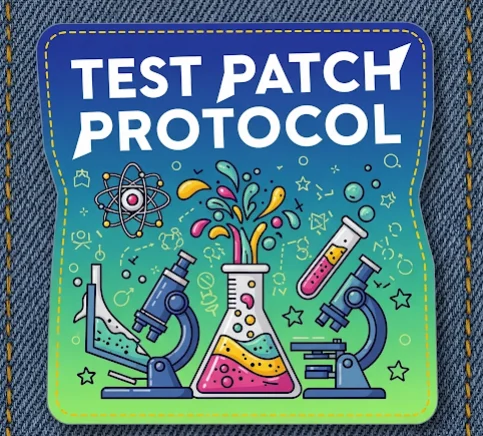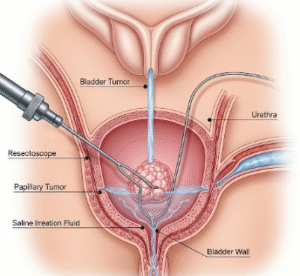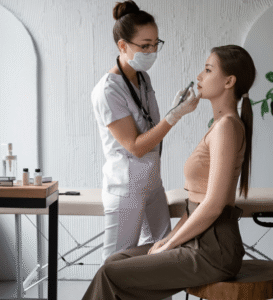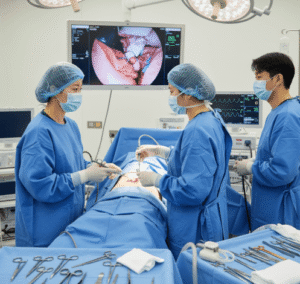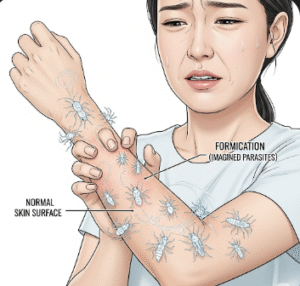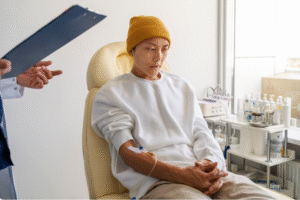What it is
→ A test patch protocol is a safety step performed before a full laser hair removal (LHR) or skin laser treatment, where a small area of skin is exposed to the laser under specific settings.
→ The goal is to evaluate skin tolerance, pigment reaction, and treatment effectiveness before proceeding with a full session.
→ It is especially important for patients with:
- Darker skin types (IV–VI) on the Fitzpatrick scale.
- History of pigmentation disorders (hyperpigmentation, hypopigmentation).
- Sensitive or reactive skin.
- New devices or first-time laser treatments.
→ In Korea, dermatology clinics commonly perform test patches as part of their standard safety protocol for international patients and those with higher-risk skin types.
Why it’s done
→ Test patches are performed to:
- Prevent complications → reduce risks of burns, blistering, or pigment changes.
- Determine safe laser settings (fluence, pulse duration, spot size, cooling).
- Check for delayed reactions (24–72 hours post-test).
- Build patient confidence by showing how skin responds before committing to a full session.
- Customize treatment plans → ensure effectiveness without compromising safety.
Alternatives
→ Alternatives to a formal test patch include:
- Starting at very low settings during the first session and adjusting upward gradually.
- Using IPL instead of lasers for cautious first exposure (though less effective).
- Skipping test patch → sometimes done in low-risk patients with light skin and dark hair.
→ However, test patches remain the gold standard for safety, especially for skin types IV–VI.
Preparation
→ Before a test patch, patients should:
- Shave the treatment area 24–48 hours beforehand (roots must remain for targeting).
- Avoid waxing, plucking, or threading for 4–6 weeks.
- Keep skin clean → no lotions, deodorants, or oils on the day.
- Avoid tanning or sunburn for at least 2–4 weeks before.
- Disclose medications (like isotretinoin, antibiotics) that increase light sensitivity.
→ Korean clinics often photograph the area before the patch for comparison.
How it’s Done
→ A test patch protocol typically follows these steps:
- Skin cleansing → remove any oils, sweat, or creams.
- Protective eyewear → worn by both patient and provider.
- Laser application → a small patch (usually 1–2 cm²) is treated at the proposed settings.
- Incremental testing → sometimes multiple adjacent patches are done at slightly different fluences or pulse widths to determine optimal parameters.
- Cooling → contact cooling, chilled air, or cryogen spray applied immediately after.
- Observation → patient is monitored for immediate reactions (redness, swelling, discomfort).
- Delayed follow-up → the area is re-evaluated at 24–72 hours, sometimes up to a week, to check for pigment changes or burns.
→ If no adverse reactions occur, the full treatment can begin at the safest effective setting.
Recovery
→ Recovery after a test patch is minimal:
- Immediate effects → mild redness or warmth, like a tiny sunburn.
- 24–48 hours → most reactions resolve.
- Up to 7 days → monitoring ensures no delayed hyperpigmentation or scarring.
→ Aftercare instructions include:
- Apply soothing gels (aloe vera, panthenol).
- Avoid sun exposure, saunas, or harsh skincare for a few days.
- Use broad-spectrum sunscreen daily on exposed areas.
- Do not scratch or pick the test area.
Complications
→ If improperly done, test patches can reveal potential risks:
- Hyperpigmentation or hypopigmentation in treated patch.
- Burns or blistering if settings are too aggressive.
- Prolonged redness or swelling.
- Patient anxiety if reactions occur (though this is informative and prevents full-area damage).
→ The advantage is that these complications happen in a tiny test area rather than a full body zone.
Treatment options in Korea
→ Korean dermatology clinics are known for rigorous safety protocols, including test patches before laser treatments:
- Standardized test patches → especially for darker or international skin types.
- Multi-platform testing → clinics often test both Nd:YAG and Alexandrite or Diode lasers to compare effectiveness and safety.
- Precision adjustments → Korean dermatologists fine-tune fluence, pulse duration, and cooling intensity based on test results.
- Comprehensive follow-up → patients are reviewed after 1–3 days before full sessions.
- Integration with skin analysis → clinics may combine test patches with AI-based skin scanners or dermoscopy to monitor reactions.
- Medical tourism focus → English-speaking staff ensure that international patients understand safety protocols.
→ With advanced technology, precise protocols, and strong emphasis on safety, Korea sets some of the highest standards for test patch procedures in laser dermatology.

